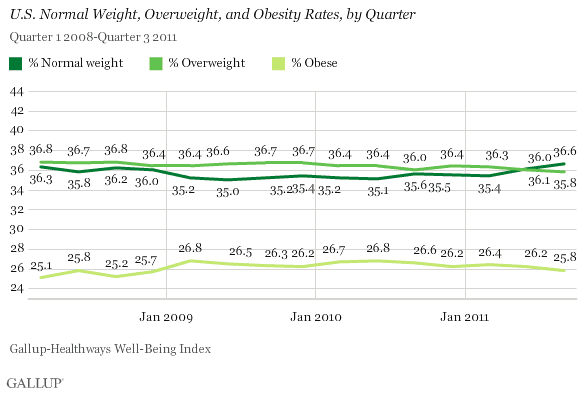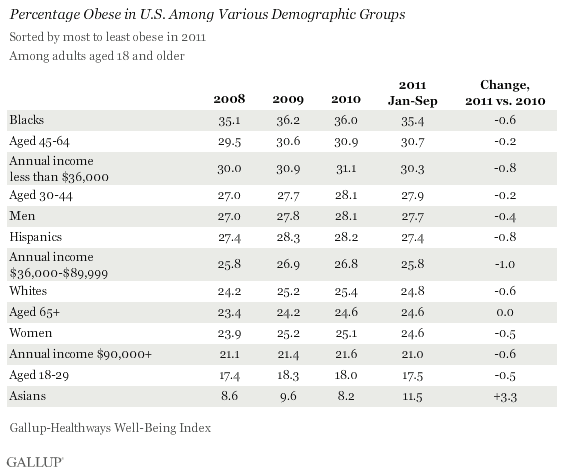WASHINGTON, D.C. -- The percentage of Americans who are overweight or obese declined slightly in the third quarter of 2011, while the percentage who are a normal weight increased. For the first time in more than three years, more Americans are a normal weight (36.6%) than are overweight (35.8%).

The overweight and normal weight trend lines have tracked closely together since Gallup and Healthways started monitoring Americans' weight situation daily in January 2008. Though it is noteworthy that more adults are now a normal weight than overweight, it is too early to tell if this shift is temporary or permanent.
The recent slight decline in the nation's obesity rate is a positive contrast to the rising levels found in 2009 and throughout most of 2010. However, the majority of Americans are still at an unhealthy weight -- either overweight or obese (61.6%).
The Gallup-Healthways Well-Being Index uses respondents' self-reports of their height and weight to calculate body mass index (BMI) scores. Individual BMI values of 30 or higher are classified as "obese," 25.0 to 29.9 are "overweight," 18.5 to 24.9 are "normal weight," and 18.4 or less are "underweight."
Obesity Rates Down Across Demographic Groups
Black Americans, the middle-aged, and those with low incomes remain the most likely to be obese across major demographic subgroups in an aggregate of the data collected in all three quarters of 2011 -- as generally has been the case historically.
However, obesity rates for each of those groups and all others included in this analysis are either trending down or are statistically unchanged so far in 2011.

Bottom Line
Although the majority of Americans are still overweight or obese, it is an encouraging sign that obesity rates are trending downward in the U.S. and among demographic subgroups. Still, future monitoring is needed to determine whether this is a temporary trend.
Although causes for the recent decline in the percentages of Americans who are overweight and obese are unclear at this point, several possibilities exist: Public awareness and government and business investment in changing Americans' health habits may be playing some role. As obesity and the chronic diseases and healthcare costs that come with it have ballooned, the media, the government, and many businesses have given the issue more attention. During the past year and a half, two major initiatives relating to Americans' health habits have come from Washington. First Lady Michelle Obama launched her anti-obesity Let's Move! campaign in early 2010 -- pushing a message about eating better and exercising more and initiating programs to help reach those goals. Separately, the U.S. Department of Agriculture in June 2011 put out a new nutrition icon shaped like a dinner plate emphasizing fruits and vegetables and eating less in general. However, these programs have not been in place for a long time, so it is not possible to determine their effect. At the same time, more businesses are investing in wellness programs for their employees -- encouraging good health habits -- to reduce healthcare costs.
Economic conditions could also be related to the decrease in unhealthy weight. Americans continue to spend far less than before the financial crisis and so may be eating at home more and dining out on high-calorie foods less.
Regardless of the exact cause, if this downward trend continues, it could significantly reduce healthcare costs in the United States, a major portion of which are currently the result of obesity and related preventable chronic conditions.
About the Gallup-Healthways Well-Being Index
The Gallup-Healthways Well-Being Index tracks well-being in the U.S., U.K., and Germany and provides best-in-class solutions for a healthier world. To learn more, please visit well-beingindex.com.
Survey Methods
Results are based on telephone interviews conducted as part of the Gallup-Healthways Well-Being Index survey July 1-Sept. 30, 2011, with a random sample of 90,070 adults -- and a similar number in previous quarters -- aged 18 and older, living in all 50 U.S. states and the District of Columbia, selected using random-digit-dial sampling.
For results based on the total sample of national adults, one can say with 95% confidence that the maximum margin of sampling error is ±1 percentage point.
Subgroups have a maximum margin of sampling error of ±3.5 percentage points.
Interviews are conducted with respondents on landline telephones and cellular phones, with interviews conducted in Spanish for respondents who are primarily Spanish-speaking. Each sample includes a minimum quota of 400 cell phone respondents and 600 landline respondents per 1,000 national adults, with additional minimum quotas among landline respondents by region. Landline telephone numbers are chosen at random among listed telephone numbers. Cell phone numbers are selected using random-digit-dial methods. Landline respondents are chosen at random within each household on the basis of which member had the most recent birthday.
Samples are weighted by gender, age, race, Hispanic ethnicity, education, region, adults in the household, and phone status (cell phone only/landline only/both, cell phone mostly, and having an unlisted landline number). Demographic weighting targets are based on the March 2010 Current Population Survey figures for the aged 18 and older non-institutionalized population living in U.S. telephone households. All reported margins of sampling error include the computed design effects for weighting and sample design.
In addition to sampling error, question wording and practical difficulties in conducting surveys can introduce error or bias into the findings of public opinion polls.
For more details on Gallup's polling methodology, visit www.gallup.com.
